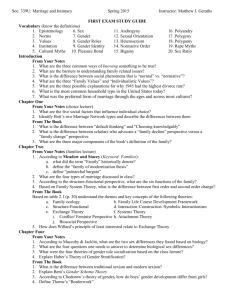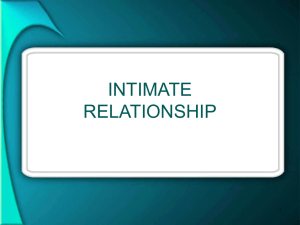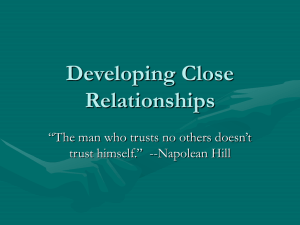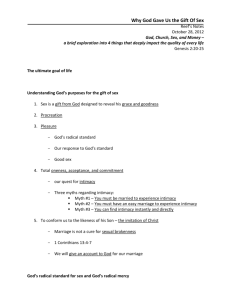attachment style
advertisement
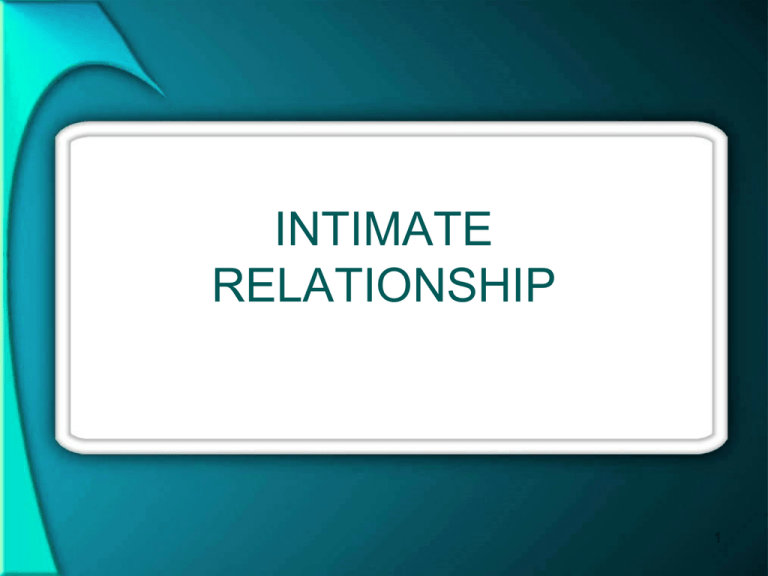
INTIMATE RELATIONSHIP 1 INTIMACY • Intimacy refers to sharing that which is inmost with others. • The word itself is derived from the Latin intimus, which means “inner” or “inmost” 2 PARENT-CHILD ATTACHMENT 3 What is attachment • Attachment refers to the strong emotional bond between an infant and a caregiver 4 • Parent-child attachment patterns influence later childhood peer relations and intimate adult relationship 5 • People with a secure attachment style have more successful intimate relationships later in life than those who are insecurely attached 6 ATTACHMENT STYLE • Secure Attachment Style • Preoccupied Attachment Style • Dismissing-Avoidant Attachment Style • Fearful-Avoidant Attachment Style 7 Secure Attachment Style • Attachments marked by trust that the other person will continue to provide love and support 8 Preoccupied Attachment Style • An expectation about social relationships characterized by trust but combined with a feeling of being unworthy of others love and fear of abandonment 9 Dismissing-avoidant Attachment Style • An expectation about social relationships characterized by low trust and avoidance of intimacy, combined with high self-esteem and compulsive self-reliance 10 Fearful-Avoidant Attachment Style • An expectation about social relationships characterized by low trust and avoidance of intimacy, combined with a feeling of being unworthy of other’s love and a fear of rejection 11 FRIENDSHIP 12 Friendship • As we mature, we not only form emotional ties with our family members, we also form friendship outside the home. 13 Friendship • Relationships based on friendship are primarily voluntary and mutually satisfying 14 SELF-DISCLOSER SHAPES FRIENDSHIP DEVELOPMENT AND MAINTENANCE • Self-disclosure –The revealing of personal information about oneself to other people 15 SELF-DISCLOSER SHAPES FRIENDSHIP DEVELOPMENT AND MAINTENANCE • Social Penetration Theory –A theory that describe the development of close relationship in terms of increasing selfdisclosure 16 GENDER DIFFERENCES EXIST IN HETEROSEXSUAL FRIENDSHIP • Intimacy – Women’s friendships tend to be more intimate and involve more emotional sharing than men’s relationship – Men are more dominant and women are more agreeable and nurturing 17 GENDER DIFFERENCES EXIST IN HETEROSEXSUAL FRIENDSHIP • Self-Disclosure – Women generally self-disclosure more than men, especially in intimate relationship • Physical Touching – Male friends less touching than did either female friends or mixed-sex friends 18 Cross-Sex Heterosexual Friendships Gravitate to an “Intimacy Mean” • Men tend to be more emotionally open and self-disclosing than they are with their male friends, while women disclose less and are not as intimate as they are with their women friends. 19 Cross-Sex Heterosexual Friendships Gravitate to an “Intimacy Mean” • Men and women are more likely to form and maintain friendships with the other sex when they have interests. • The biggest problem in cross-sex friendship is sexual tension. 20 Gender Differences Disappear in Same Sex Homosexual Friendship • Same-sex relationships of gay men are as intimate as those of lesbians 21 ROMANTIC RELATIONSHIP AND LOVE 22 Romantic Relationships and Love • The experience of romantic love differs from person to person, culture to culture, and over historical time. 23 LOVE • Social psychologists have recognized that a good definition of love must include the passionate, giddy feelings of romantic love as well as the deep, long term devotion of a long-married couple, lifelong friends or siblings 24 LOVE • Triangular Theory of Love – The idea that different kinds of love consist of varying degrees of three components: intimacy, passion and commitment 25 Figure 9.1: The Triangle love 26 Triangular Theory of Love • Intimacy – Refers to feelings of being close to and bonded with a partner • Passion – Refers to the “hot” parts of a relationship – the arousal you experience toward your partner, including sexual attraction 27 Triangular Theory of Love • Commitment – Consists of two decisions: the short-term one that you love your partner and the long-term one to maintain that love and stay with your partner 28 MARRIAGE 29 Marriage • A general definition of marriage is that it is a social contract between two individuals that unites their lives legally, economically and emotionally. 30 Marriage • Broderick (1984) stated that marriage has 9 characteristics 31 Marriage 1. Marriage is a social event 2. Marriage is a relationship between two families and social network 3. Marriage is a legal agreement between individual and state 4. Marriage is an economy united 5. Marriage is a common order for adult 32 6. 7. 8. 9. Marriage is a context for sex Marriage is a reproductive unit Marriage is for socialization Marriage is to build intimate relationship and sharing 33 Types of Marriage • Monogamy – having only one husband or wife at a time • Serial Monogamy – practice of having series of partners : the idea or practice of having only one sexual partner at a time and entering another relationship when one comes to an end 34 Types of Marriage • Polygamy – having several wives or husbands at the same time • Polygyny – A man has two or more wives at the same time • Polyandry – A woman has two or more husband at the same time 35 ENDING INTIMATE RELATIONSHIP 36 People used different strategies to cope with a troubles relationship • In dealing with relationship dissatisfaction, we employ four distinct strategies: – Loyalty – Neglect – Voice – Exit 37 People used different strategies to cope with a troubles relationship • Loyalty – Passively but optimistically waiting for conditions to improve (hoping things to improve, pray, being supportive instead of fighting) • Neglect – Passively allow conditions to deteriorate (refusing to deal with problems, ignoring partner/spending less time together, putting no energy into the relationship) 38 People used different strategies to cope with a troubles relationship • Voice – Actively & constructively attempting to improve condition (discuss problems, try to change, going to therapist) • Exit – Actively harming or terminating the relationship (abusing partner, threaten to break up, actually leaving) 39 ENDING INTIMATE RELATIONSHIP • Researches have begun to examine what makes people end their relationship and the disengagement strategies they use 40 The Process of Breaking Up • According to Steve Duck, relationship dissolution occurs in four stages 1. Intrapersonal phase – Think a lot about dissatisfaction with the relationship 2. Dyadic Phase – The individual discuss the break up with the partner 41 The Process of Breaking Up 3. Social Phase • The breakup is announced to other people 4. Intrapersonal Phase • The individual recover from the breakup and forms an account of how and why it happened 42 Figure 9.2: Steps in dissolving close relationship 43 THE EXPERIENCE OF BREAKING UP • Akert (1998) found that the role people played in the decision to end the relationship was the single most powerful predictor of their experiences. • Breakess were most upset 44 THE EXPERIENCE OF BREAKING UP • Women experienced somewhat more negative emotions than men • When the breakup is mutual, partners are more likely to remain friends after the relationship 45
